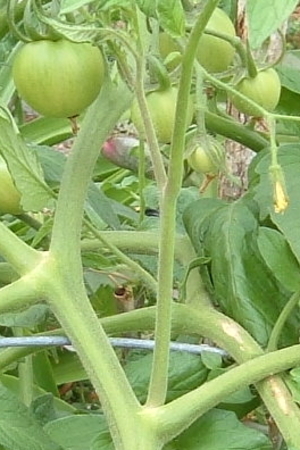Imagine having fresh-picked, vine-ripened tomatoes from your garden in February when most of the north is covered in snow. Having gardened in Florida for over 15 years, I’ve learned more about growing tomatoes in a tropical climate than I ever thought I needed to know. One of the best things I learned, mostly through trial and error, was how to keep tomatoes growing year-around. Oh sure, sometimes there is a freak freeze, and you have to cover them all up and hope for the best, but most of the time, there is nothing to keep you from harvesting luscious, juicy tomatoes in South Florida for 12 months of the year.
Tomato plants provide easy propagation material by putting out shoots called “suckers” in the leaf nodes (where the leaf meets the stems). Called suckers because they suck nutrition from the main plant, it’s best to remove them so your plant will produce the largest and healthiest fruit possible. When the tomato suckers are approximately 4 to 6 inches tall, depending on the variety, you can very easily remove and root them, creating another tomato plant that will eventually bear more tomatoes. For a continuous harvest, you will root suckers about every two weeks. It’s best to root these in small pots, then transplant to the garden. It’s possible to simply stick the tomato suckers into the garden soil and keep them watered, and they will grow there, however, they will also be more prone to disease, and won’t live as long.
Taking and Sticking Tomato Cuttings
Simply remove a three- to six-inch tomato sucker by grasping it at the point where it joins the stem and bend to snap it off. They break off very easily at this size. You now have a tomato cutting.
Strip all by the top two sets of leaves from the tomato cutting, and bury 2/3 of the stem in sterile potting mix in a small pot or peat pot. There is really no need to use rooting hormone, as they root very easily, but you can if you want.
TIP: You can recycle toilet paper rolls as peat pots. Because they are tall, they cause the tomato roots to grow downward instead of outward, which is a good root structure for the garden, as the roots will be deeper and not need as much watering.
Watering and Fertilizing Your Cuttings
For the first watering, water the tomato cuttings with a solution of 1 teaspoon Epsom salts to a quart of water, or 1 tablespoon to a gallon. This encourages the tomato cutting to form roots.
The cuttings will wilt. Don’t worry, just keep them moist, and they will soon come around.
Once the cuttings perk up, you can start fertilizing them with your favorite brand of acid based soluble fertilizer, mixed at a rate of 1/4 teaspoon liquid fertilizer to a gallon of water. Organic gardeners may use fish emulsion mixed at half strength.
Once they start growing, fertilize with acid-based soluble fertilizer mixed at a rate of 1 teaspoon to a gallon of water, or fish emulsion mixed at a normal rate.
Further Information
It will take the tomato cuttings a month to 6 weeks before they are ready to be planted in the ground. You may also at this time transfer them to larger pots, and plant them out later if you wish.
You can also take tip cuttings from leggy tomato plant limbs and use this same method to propagate them. Be sure to remove all blooms from the cuttings before sticking them, as they will not root while trying to produce fruit. If you take limb tip cuttings over 6 inches, be sure to bury at least half of the cutting when sticking.
By staggering the plantings, you will have a much longer tomato harvesting season. Regular tomatoes can be grown 9 months out of the year in South Florida, and cherry and grape tomatoes can be grown all year.
When regular tomatoes stop bearing due to the summer heat in South Florida, propagating tomato suckers and growing them out into larger pots will give you a jump-start on your planting in September.
Sources:
Personal knowledge and experience





